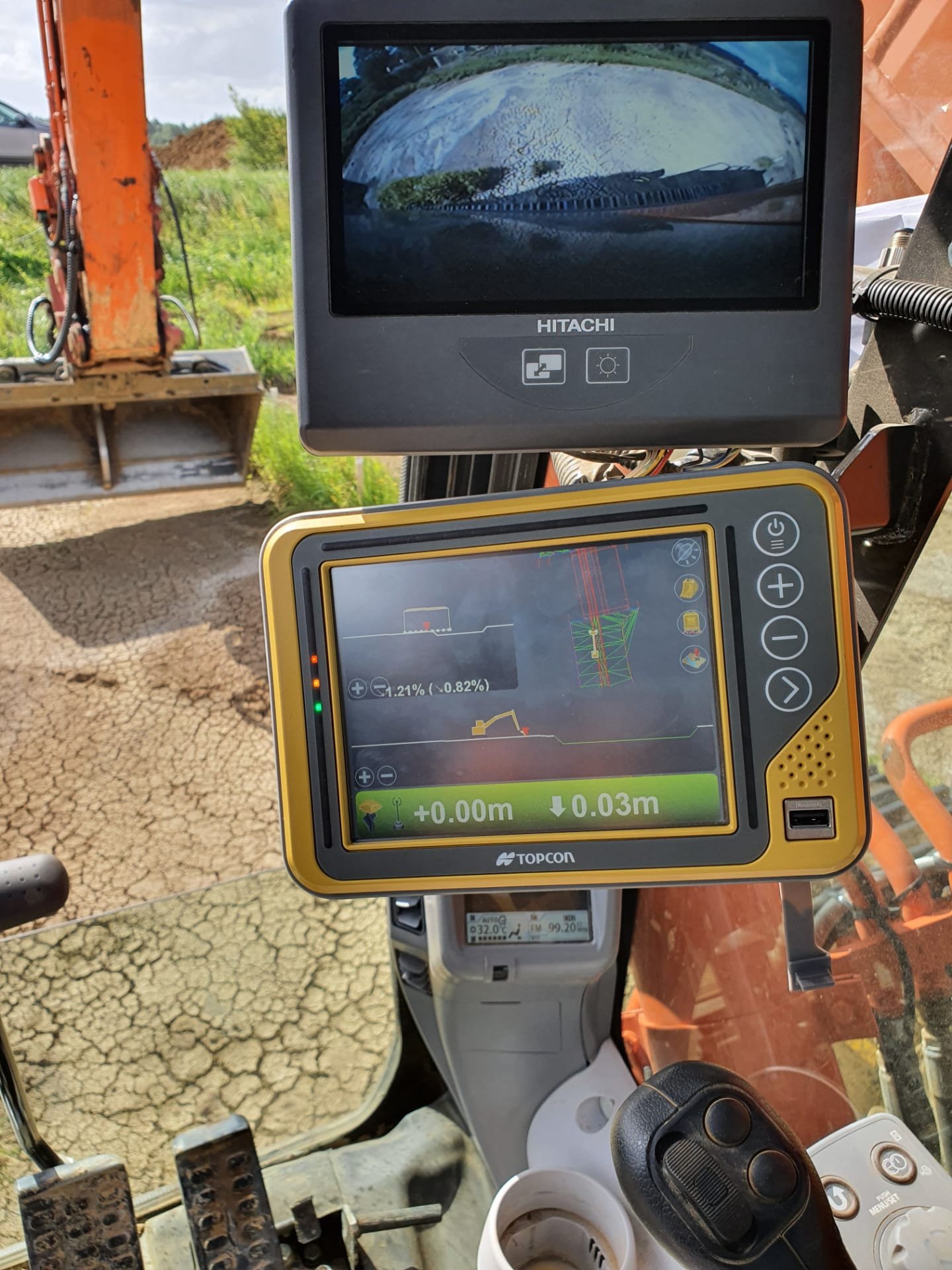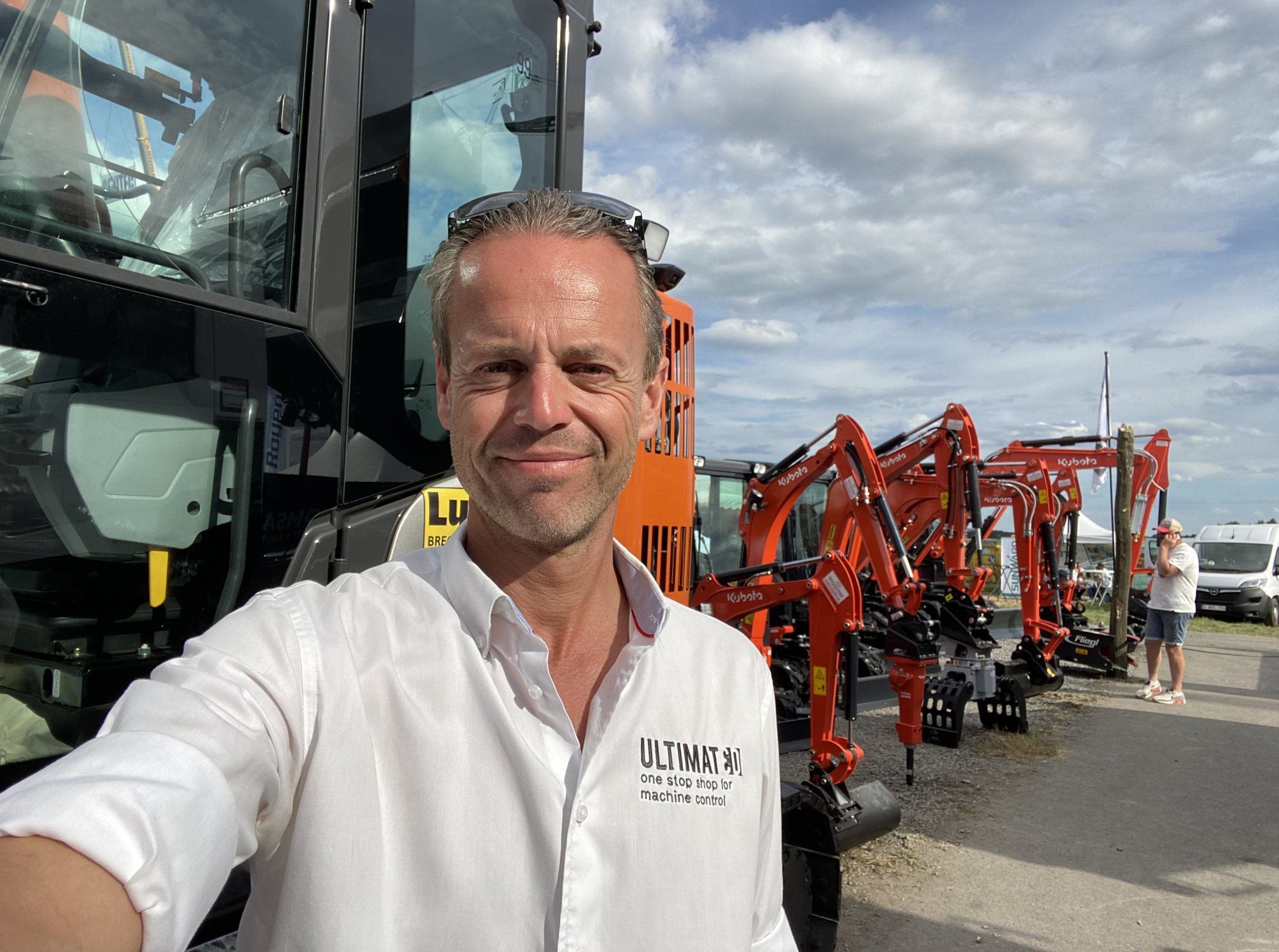Luyckx news

01.12.2022
BLOG: Ultimated
Going the extra mile, or, in other words, taking care of everything. Luyckx is well-known for this among its customers. But not everyone is familiar with Ultimated, a joint venture between Luyckx and 3D-Consult (an independent service provider for machine control and 3D modelling). Together, they form a unique one-stop shop for companies in (road) construction, infrastructure and earthworks. Ultimated’s Sam Van Campenhout will tell you all about it…
No more rolled-up plans in the cabin
Sam, what exactly does Ultimated do?
Sam: We provide a full-service solution for our customers with regard to excavation indicator systems and machine control in earthmoving machines, especially excavators and bulldozers. But we’re also a Topcon dealer for land surveying equipment. So, among other things, we sell total stations.
Can you explain in plain language the difference between an excavation indicator system and machine control?
Sam: An excavation indicator system provides operators with a 3D-model of the construction plans. They see what needs to be excavated or raised. The link between that system and the machine itself is of course the operator.
With automated systems, the crane operator only needs to use his stick. The boom and tilt of the bucket are controlled by the system. In bulldozers, both the angle and height of the blade are controlled. In that case, the operator only needs to drive forwards and backwards.

An excavation indicator system in the cab.
So that makes their job quite easy?
Sam: That’s right, but don’t underestimate the work. You still need great insight to interpret each situation on site, to know how to direct the machine and where to push the excess material to. It’s a complex job. But of course, the operator enjoys a greater level of comfort and can work much quicker and more precisely. And they no longer need a rolled-up plan in their cabin (laughs). Without our system, they would constantly need to manually adjust the gradient and height. In the past, you would often have an extra man on hand to give directions and check their position. Now, our system takes over those tasks entirely. And it's safer!
So you introduce technology to machinery?
Sam: You could say that. Of course, it depends on the type of work the crane or bulldozer is used for. There’s no need for a transhipment crane to be fitted with this technology. But machines that raise, excavate, level and whatnot, those we make “smart”. The most important consideration is, of course, that the investment in a machine should produce the greatest possible return for the customer. In other words, it should be more profitable than without machine control. That’s what counts.
Plan A and plan B
Do you always use GPS technology?
Sam: Look, the common denominator is always 3D. You have a position, X-Y coordinates, and then there’s Z, height. You can arrive at 3D through two techniques: either via GPS or using a total station. GPS is the most common, plan A, so to speak. But unfortunately, GPS has its limits. Inside a building it won’t work because there’s no GPS signal. And next to a high wall or under trees, the signal is often weak. Furthermore, the system continuously needs to capture the GPS correction signal, otherwise you lose precision. So, the alternative is to use a total station. That makes an optical connection, so you won’t have any signal issues. That’s plan B. It’s also the most expensive solution and it requires a lot of methodical expertise in terms of positioning the total station. In most cases, the GPS system will do the trick. In the rare cases when it doesn’t, we switch to a total station.
So it saves time and it’s real precision work. Does that mean you need to be a perfectionist?
Sam: I have to admit… I am one (laughs). Do you have to be? Yes, but don’t take it too far. To install the system and measure up, you have to be, of course, but once it’s calibrated, the machine becomes the perfectionist (laughs).
Happy operators
Is it hard to get the hang of the system?
Sam: It’s all right, you know. We take our customers by the hand at the start-up. An important part of our service is training our customers and offering support in the first days and weeks after taking the machine into operation. We advise, install, measure, and calibrate. And we explain the process in minute detail. We also speak the operators’ language. And we’ve noticed that once they get the hang of it, they become big fans (laughs). I often get sent pictures of machines in action with a happy operator. That’s what we aim for.

The team is happy to provide training to customers.
Why is that so important?
Sam: Well, we don’t want to refer our customers to some anonymous help desk. We want them to be helped by the person who trained them, because that person knows the customer’s background through and through.
What happens after training?
Sam: We’re obviously invested in providing after-sales service. The main idea is always: to take as much as possible off the customer’s hands and to help them as quickly as possible when there’s a problem, so their machine suffers as little downtime as possible.
And these systems are continuously evolving?
Sam: Absolutely. When I look at how fast things have developed in the last four years, it’s really incredible. The sensors are becoming faster all the time, we’re getting ever more beautiful and well-organised graphic interfaces and more user-friendly communication tools, so that you can, for instance, manage and follow up your whole fleet from your office. It’s constantly evolving and we’re following these developments closely.
One-stop shop
What makes your approach so unique?
Sam: That we’re a one-stop shop, without a doubt. For many dealers, setting up a system is the end point, whereas for us that’s the starting point. It’s the start of a long-term relationship with our customers and their operators. We want to make sure that they can make their money back on their investment. We do that with great enthusiasm and with practical expertise. We provide a full-service solution. Furthermore, we have in our warehouses a large stock of every possible system component. So we’re as good as our word: if there’s a problem, we’ll solve it. Now I’m sounding like Jos Luyckx (laughs).
In close collaboration with Luyckx’ engineering department, we’ve developed sea-proof casings that we install on all cranes that are used for dredging operations. That has resulted in a great decrease in steering-related issues.

This crane was used for dredging work.
Over the past four years, we’ve developed dozens of brackets, containers, antenna supports and other parts for several brands of machines, which are produced by Luyckx. We also sell these to other dealers. That way, we don’t need to make brackets on site during an installation, allowing us to spend more time on, for instance, optimising cable routing.
We also focus strongly on safety. We offer kits that allow operators to safely reach the antennae or prism on top of the bulldozer blade. As far as I’m aware, we’re the only player in the market right now who offers this standard.
You are also active in the Middle East?
Sam: That’s right. Our sister company is MEC (Middle East Crane). We operate from the same building. After-sales service is perhaps even more important in the Middle East. There, we only install our systems on very large machines that are mainly used for dredging. These often operate from pontoons. If one of those machines stops working, it immediately affects other teams, causing a domino effect. So, that can get very expensive very quickly.
That’s why we build the machines in such a way that all sensors and cables are extra well protected from water, hard objects… And if something happens after all, we’re organised in such a way that we can quickly replace sensors and/or cables.

A grader with automatic system.

3D-milling.
So you’re often in Dubai?
Sam: Yes, on average I’m there about once a month for a week. I follow up on most installation works.
How do you see Ultimated’s future?
Sam: I think we will continue to evolve towards a service model, because manufacturers are increasingly producing ready-made machines, so with a system already installed. The downside is that these components are often fully integrated into the machine and are therefore harder to remove.
The upside of our after-market system is that we can effortlessly transfer machine control systems from one machine to another. What we have installed ourselves, is relatively easy to re-install. You see, customers tend to replace their machines before a system’s life cycle is over. So, I don’t have to tell you that this is a very interesting model. It’s a great advantage, compared to an integrated machine in which everything is intertwined. In other words, we make sure that the system can be flexibly installed and that the machine is always operational. That gives our customers great peace of mind, of course.
And technologically speaking?
Sam: Undoubtedly, AI (Artificial Intelligence) will one day be introduced in the world of machinery, but of course we don’t have a crystal ball.
An extra pair of eyes
Why do you love this job so much?
Sam: It gives great satisfaction to equip this large and heavy machinery with technology and then to see that all that brute force can be made to perform very delicate work. In a way, we’re giving the operator an extra pair of eyes, allowing them to do their job more efficiently and safely. And like I said, we get a lot of appreciation and that’s fun, of course.
And apart from the technical challenges, I also love my job because of the special family atmosphere in this company. You work hard without even realising it. There’s mutual respect, helpfulness, and collegiality… And what’s also nice: things move forward. Once a decision has been made, we just do it. Well… that’s Luyckx, you know! (laughs)

Sam Van Campenhout, director of Ultimated.
